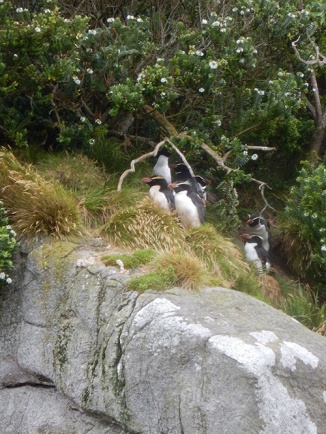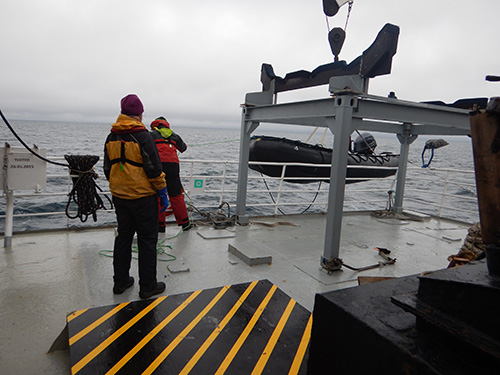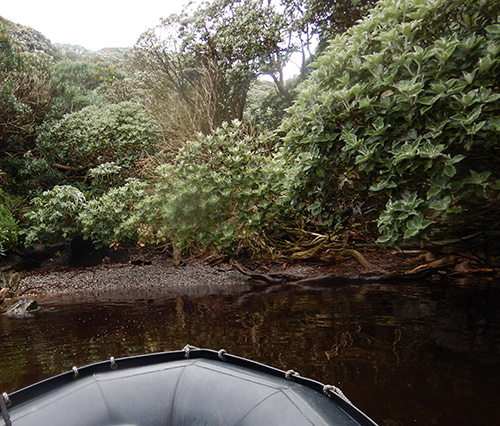The closest Subantarctic Island to New Zealand, The Snares is a group of 8 small islands and several rock stacks lying just 100 km southwest of Stewart Island at 48⁰ South. Formed from uplifted and eroded muscovite granite, the geology of the islands formation was plain to see from the ship’s deck and as we cruised along the east coast of North East Island, the largest of the small group. To the south-east lies Broughton Island and the islets of the Western Chain trail down to the south-west. Rising abruptly out of the ocean on steep cliffs, at its highest point North East Island only reaches 152 meters above sea level and covers just 258 hectares. The most striking thing about The Snares, after their geology, is how green they are. The island is exposed to the southern boundary of the warm Subtropical Convergence Zone, flowing from the western Tasman Sea and keeping the islands temperature comparatively mild, at an average of 11⁰C.

The Snares east coast viewed from the ship’s top deck, 6 am 24/12/15
Covered in layers of rich peat, this island supports thick canopies of two species of large tree daisy: Olearia lyallii and Brachyglottis stewartiae, their wind-bent trunks and branches forming impenetrable scrub with an understorey of ferns, herbs including the shore herb Hebe elliptica and the megaherbs Stilbocarpa robusta and Anisotome acutifolia, endemic to The Snares. Another endemic plant is a form of Cook’s Scurvy Grass, Lepidium oleraceum. This cress was used by Captain Cook to ward off scurvy in his crews in the early days of European exploration in New Zealand.

Tree daisy forest and understorey, with Stilbocarpa robusta in the foreground
Grasses dominate in some areas of the island, large tussocks and smaller grasses concealing nest burrows of the native titi, or Sooty Shearwater Puffinus griseus. Also known as Muttonbirds and a traditional food to Maori, titi are the most abundant birds nesting on The Snares. Their deep (up to 3m) burrows honeycomb the peat underneath tussocks, scrub and forest. They nest on the island in the southern summer, then migrate to the North Pacific over open ocean, feeding on small fish, squid, crustaceans and jellyfish, circling back down the globe to nest at The Snares the following summer. It has been suggested that Maori visited the islands historically to harvest titi and the islets of the Western Chain still bear their Maori names of Tahi, Rua, Toru, Wha, and Rima (the numbers 1 to 5). The Maori name for The Snares is Tini Heke.

The forces behind the island’s formation can be seen in eroded granite outcrops along the coast
The islands were ‘discovered’ by 2 European ships at different times on the same day, November 23 1791. The HMS Discovery and HMS Chatham were both part of the Vancouver expedition, but it was not until the 2 ships met again over a month later in Tahiti that Captain Vancouver of the Discovery and Lieutenant Broughton of the Chatham realised they had must have missed each other by only a matter of hours that day. The name of The Snares was bestowed by Vancouver as he considered the islands a shipping hazard (McNab, 1907 p.35.) The islands history has a gruesome chapter – there is a story from the early 19th century of a group of 4 sealers abandoned on the island for 7 years. When they were finally recovered by an American ship in 1817 only 3 remained, leading to a murder trial in the courts of New Zealand (McNab, 1907 p.155.) Fur seals were harvested from The Snares, but lacking good landing beaches or harbours the islands escaped heavy damage from occupation by the sealing and whaling trades.
Without regular occupation from Europeans and their accompanying rats, mice or cats (or other pests), The Snares are the only Subantarctic islands with no history of terrestrial vertebrate pests. This has left the abundant and diverse bird population largely intact – titi, diving petrels, fairy and fulmar prions, skuas, Buller’s, Salvin’s and Black-browed Albatross (or Mollymawks), the Snares Island fernbird, snipe and tomtit are all found on the islands. There are some introduced birds including redpoll and mallard that likely migrated from the New Zealand mainland. The main threats to the island’s birds come from the effects of climate change on the islands vegetation and impacts from fishing and pollution.
High density populations of seabirds use the islands for resting and breeding, the most iconic being the endemic Snares Crested penguin Eudyptes robustus. One of the small crested penguins, these birds feed in the ocean in groups and when on land convene in the tree daisy forest. There are approximately 100 breeding colonies on the island, and the penguins follow cleared thoroughfares down to the water’s edge. The islands rocky crags were thickly covered in penguins moving towards or out of the ocean, resting, fighting and posturing.

Snares Crested penguins

Snares Crested penguins and kelp
Fringed with 114 species of seaweed and kelp (Peat, 2003 p. 23), The Snares rich shoreline provides food and hauling out places for Hookers sea lion and the New Zealand fur seal. Both species breed on the islands, their numbers slowly recovering from the depredations of the sealing trade.

New Zealand Fur Seal
No tourist landings are permitted at The Snares, but the islands have been extensively studied in the past and are the subject of studies by the Museum of New Zealand, aiming to learn more about the wildlife and botany of these fascinating islands.
Journal Extract
24/12/15 Evening
Almost 49⁰S, rolling with a strong westerly airflow. Ship pitching. Today we were lucky (prev. 2 trips have not been able to do this) and took a Zodiac cruise of The Snares. Saw multitudes of endemic Snares Crested Penguins, a couple of stray Rockhoppers and my first sight of penguins ‘porpoising’ – as a group they move through the water, leaping out then arrowing back down in pursuit of fish, squid, each other. Seals and sea lions hidden in plain sight on sudden cliffs.

Snares Crested penguins porposing. Copyright Henry Cook
Struck by how colourful the islands and surrounds are. Sapphire clear blue water, great red, golden and green whorls of kelp and algaes. Thick green and silver daisy tree forest spangled with white and golden blooms. Black endemic Tomtit flitting along the cliff face, dipping behind tangled branches.

Layers of colour in the landscape
The geology is astounding. Gondwana granite uplifted and spilt into angular geometric shapes, eroded into astonishing outcrops. Tui was driving the Zodiac I was in, she took us into a small sheltered cove where we could see a research hut (abandoned) and penguins in amongst the trees and herbs. Nesting and courting albatross on the cliff faces, flash of a fanned tail as he convinces her to stay another year. Antarctic terns spotted on rocks. Shearwaters aplenty, Skua gulls keeping watch as sea lions scrap in the tide pool.

Sea lions sorting out the pecking order

Penguins emerging from the Hebe and grasses in the tree daisy forest

Abandoned research hut still visible through the canopy
Today’s visual and sensory feast was worth tonight’s queasiness. The Expedition leader is assuring us we just have to roll with the swell, one hand for yourself, one hand for the ship at all times. It’s a steep swell, should ease by tomorrow. ‘Smile’ he says. Puts it into perspective (a bit), what Cook, Vancouver etc. & crews would have lived through. At least I don’t have scurvy, night watches or rigging ratlines to contend with (let alone drunk, mutinous crew and completely uncharted courses.) The MS is not liking seasickness and symptoms are banging for attention, distracting myself by looking through today’s photos and planning for tomorrow’s landing on Enderby Island.
A word on Zodiacs
Life jacket on, line up and wait your turn. Step down the narrow metal gangway lowered down the side of the ship (port or starboard, depending on conditions), stand on the small square platform and wait for the Zodiac pontoon – the inflated side of the raft – to be at the same level. In the Southern Ocean swell, with the ship rolling. At the word of the Russian sailor on the end of the gangway, step onto the pontoon then into the Zodiac. The sailor steadies your arm, and your guide pulls you in. Reverse for getting out. Trust the sailors and always listen to your guide – they’ve done this many more times than you.

Preparing to launch
Zodiac launches were the biggest challenge I anticipated on the expedition, given my MS symptoms of vertigo, unpredictable balance and random leg weakness. They were a definite challenge, especially the first launch at The Snares where we were on a large swell. But with my determination not to miss a thing a huge motivator, by the last launch I felt like an old hand helped, no doubt by the relatively calm conditions we had for landings during the rest of the trip.

Zodiac being lowered for launch
The ship had 5 Zodiacs, stored on the 400 level deck. Lowered by a small crane into the water, they were an essential part of the expedition. Only from a Zodiac could we get so close to and/or land on the shores of every island visited, exploring at water level otherwise inaccessible coastlines with their sea caves, perpendicular cliffs and vibrant marine life.

Only in a Zodiac

Penguin Highway

Bull Kelp

Uplifted Granite

A rare beach, possibly the only one on the island

Snares crested penguins amongst kelp whorls

Shoreline swell

Fur seal keeping watch
